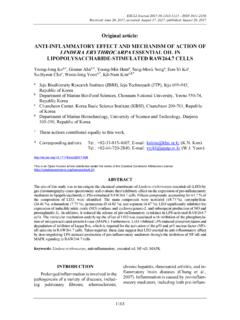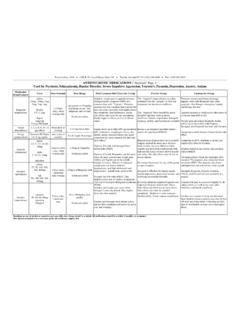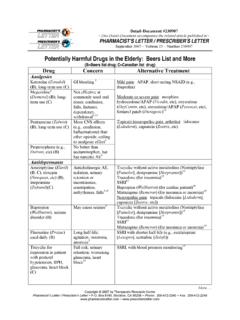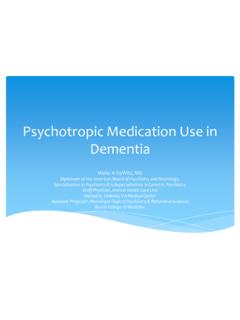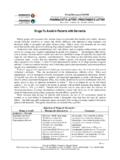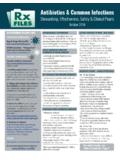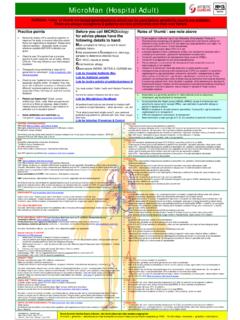Transcription of Review article: CLINICAL PHARMACOLOGY OF ATYPICAL ...
1 EXCLI Journal 2014;13:1163-1191 ISSN 1611-2156 Received: June 20, 2014, accepted: July 27, 2014, published: October 13, 2014 1163 Review article : CLINICAL PHARMACOLOGY OF ATYPICAL ANTIPSYCHOTICS: AN UPDATE Mauri1*, S. Paletta1, M. Maffini1, A. Colasanti2, F. Dragogna1, C. Di Pace1, Altamura1 1 Department of Neuroscience and Mental Health, Pychiatric Unit, CLINICAL Neuropsycho- PHARMACOLOGY Unit, University of Milan, Fondazione IRCCS Ca Granda, Ospedale Maggiore Policlinico, Via F. Sforza 35, 20122 Milan, Italy 2 Center for Affective Disorders, Department of Psychological Medicine, Institute of Psychiatry, King's College Denmark Hill, London SE5 8AF, England * Corresponding author: Mauri, CLINICAL Psychiatry, CLINICAL Neuropsychopharmacology Unit, University of Milan, Fondazione IRCCS Ca Granda, Ospedale Maggiore Policlinico, Via F. Sforza 35, 20122 Milano, Italy. Telephone number: +390255035997; fax number: +390255035990; e-mail: ABSTRACT This Review will concentrate on the CLINICAL PHARMACOLOGY , in particular pharmacodynamic data, related to ATYPICAL antipsychotics, clozapine, risperidone, paliperidone, olanzapine, que-tiapine, amisulpride, ziprasidone, aripiprazole, asenapine, iloperidone, lurasidone and caripra-zine.
2 A summary of their acute pharmacokinetics properties are also reported. Four new second-generation antipsychotics are available: iloperidone, asenapine, lurasidone and in the next future cariprazine. Similar to ziprasidone and aripiprazole, these new agents are advisable for the lower propensity to give weight gain and metabolic abnormalities in comparison with older second-generation antipsychotics such as olanzapine or clozapine. Ac-tually lurasidone seems to be best in terms of minimizing unwanted alterations in body weight and metabolic variables. Therapeutic drug monitoring is not strictly necessary for all of the new antipsychotic drugs because there are no unequivocal data supporting a relationship between plasma drug levels and CLINICAL outcomes or side effects. The exception can be represented by clozapine for which plasma levels of 350-420 ng/ml are reported to be associated with an increased proba-bility of a good CLINICAL response.
3 Also for olanzapine an established therapeutic range (20-50 ng/ml) is proposed to yield an optimal response and minimize side effects. INTRODUCTION The primary distinction between classical and second-generation antipsychotics has been made on CLINICAL basis. Actually con-ventional or typical antipsychotics are characterized by undesirable side effects such as extrapyramidal symptoms (EPS), hyperprolactinaemia, tardive dyskinesia and possible neuroleptic malignant syndrome. These symptoms are specific to the group as a whole and generally associated with high doses but in some cases also at clinically ef-fective dosages. The second-generation or ATYPICAL antipsychotic drugs can be differ-entiated from traditional antipsychotics by their low or negligible levels of these un-wanted side effects, by effectiveness and in general supposed increased safety.
4 This latter EXCLI Journal 2014;13:1163-1191 ISSN 1611-2156 Received: June 20, 2014, accepted: July 27, 2014, published: October 13, 2014 1164 has been recently questioned for the inci-dence of symptoms linked to metabolic syn-drome. The multiple CLINICAL and adverse effects of different antipsychotics depend on the combination of receptors occupancy, but the dopamine pathway is still considered the primary common target for all antipsychotic drugs. More specifically, no drug has yet been identified with antipsychotic action without a significant affinity for D2 recep-tors. There are 5 types of dopamine receptors in human beings: types 1 and 5 are similar in structure and drug sensitivity, and these two receptors are referred to as the "D1like" group or class of receptors. Dopamine recep-tor types 2, 3, and 4 are also similar in struc-ture and are, therefore, grouped together as the "D2like" group.
5 Dopamine receptors 2, 3 and 4, however, have significantly different sensitivities to antipsychotic drugs. Although the D1like receptors are men-tioned as a primary target for antipsychotic drugs, several findings indicate that they are not clinically relevant. Of the 3 D2like receptors, only the D2 receptor itself is blocked by antipsychotic drugs in direct relation to their CLINICAL anti-psychotic potencies. In particular the CLINICAL efficacy of antipsychotics is associated with a blockade of 60 % to 80 % of D2 receptors in the brain as measured by positron emis-sion tomography (PET) or single photon emission tomography (SPET). D2 receptor blockade in the brain is a general pharmacodynamic property of all antipsychotics, and without it a drug will not show any antipsychotic properties. With conventional antipsychotics the level of D2 receptor blockade is directly related to the antipsychotic effect but with ATYPICAL agents the situation is more com-plicated (Seeman, 2002; Meltzer, 2002).
6 Three theories for ATYPICAL antipsychotic action are reported. The "fast-off-D2" theory proposes that typical antipsychotics bind more tightly than dopamine to the dopamine D2 receptor in its functional high-affinity state, with dissociation constants lower than that for dopamine. On the contrary, the atyp-icals bind more loosely than dopamine to the dopamine D2 receptor, with dissociation con-stants higher than that for dopamine. A typi-cal example is represented by clozapine and quetiapine (Seeman, 2002; Meltzer, 2002). Rapid dissociation from D2 receptors is one explanation for the improved EPS pro-file of ATYPICAL antipsychotics, and one that is also consistent with the theory of a lower affinity for D2 receptors for these drugs (Miyamoto et al., 2005; Horacek et al., 2006). The dopamine-serotonin antagonism the-ory generally predicts a separation between typicals and atypicals, except that out of 20 antipsychotics there are apparent exceptions to this theory: amisulpride and remoxipride are an important exception.
7 Blockade of 5HT2A and D2 receptors was, in 1989, first labelled a pharmacodynamic mechanism that differentiated conventional from ATYPICAL antipsychotics. Meltzer (2002) defined ATYPICAL antipsychotics as drugs showing a higher affinity for 5HT2A recep-tors than for D2 receptors and a lower affini-ty for D2 receptors than was seen with con-ventional antipsychotics. For the nigrostriatal dopaminergic pathway, a model was sug-gested in which blockade of 5HT2A receptors should lead to increased output of dopamin-ergic neurons into the striatum leading to displace the antipsychotic drug from its bind-ing to D2 receptors. This could decrease the risk of EPS development (Horacek et al., 2006) (Figure 1). There is the theory which predicts that new antipsychotics stimulate S-HT2A recep-tors by inverse agonism. Although it has long been known that the stimulation of 5HT1A receptors in animals can alleviate cat-alepsy caused by D2 blockade, there do not appear to be any antipsychotics that have this 5HT1A stimulating action combined with D2 blocking action.
8 It has been proposed that the stimulation of 5HT2A receptors by an inverse action is an important contribution to atypi-cal antipsychotic action. However, although EXCLI Journal 2014;13:1163-1191 ISSN 1611-2156 Received: June 20, 2014, accepted: July 27, 2014, published: October 13, 2014 1165 some authors proposed that M100,907 has the desired stimulating action, this com-pound has shown no antipsychotic activity in humans. Figure 1: ATYPICAL antipsychotics: proposed me-chanisms of action (modified by Seeman, 2002) On the other hand the original classi-fication of antipsychotics according to their chemical structure ( phenothiazines, thio-xanthenes, butyrophenones and diphenyl-piperidines) and prevailing sedative or anti-psychotic (incisiveness) potential is still rele-vant for the conventional antipsychotic agents.
9 The classification of ATYPICAL anti-psychotics is linked essentially to their pharmacodynamic properties, which reflect their affinities for specific receptors. Atypi-cal antipsychotics with a high selectivity for serotonin 5-HT2A receptors and dopamine D2 receptors (and also 1-adrenoceptors) are called serotonin-dopamine antagonists (SDA) (risperidone, its metabolite paliperi-done, ziprasidone, iloperidone, lurasidone). Drugs showing an affinity for 5-HT2A, D2 and receptors of other systems (cholinergic, histaminergic, 5-HT1A, 5-HT1C and others) are designated as multi-acting receptor-targeted antipsychotics (MARTA) (clozap-ine, olanzapine, quetiapine, asenapine). Drugs that preferentially block D2 and D3 subtypes of the D2-like receptors are classi-fied as combined D2/D3 receptor antagonists (amisulpride).
10 A final class of ATYPICAL anti-psychotics are the partial dopamine receptor agonists (aripiprazole and cariprazine) (Horacek et al., 2006) (Figure 2, Table 1). Neuroplasticity refers to the ability of the nervous system to adapt to environmental changes and includes both synaptic plasticity consisting of remodelling of the synapses or development of new neuronal connections and neurogenesis with the development of new neurons. ATYPICAL antipsychotics are reported to induce restructuring of neuronal networks by inducing neuroplastic changes. This effect contributes to a more substantial description of the interaction between anti-psychotics and the neurodevelopmentally altered function and structure of the brain in schizophrenic patients. Moreover it can ex-plain the longterm antipsychotic effect, sug-gesting a remodelling of neuronal structures (Miyamoto et al.)


